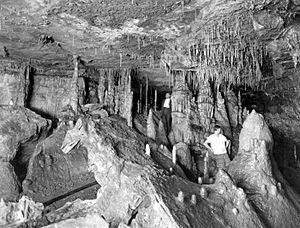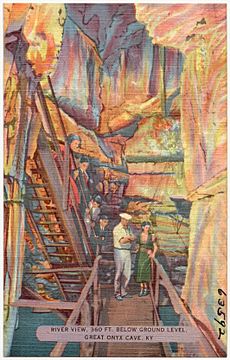Great Onyx Cave facts for kids
Great Onyx Cave is a fascinating cave located in Mammoth Cave National Park in Kentucky, United States. The National Park Service offers fun tours inside the cave for visitors to explore its wonders.
How Great Onyx Cave Was Found
Great Onyx Cave was discovered in 1915 by a man named Edmund Turner. He was an explorer who knew a lot about caves.
One story says that Turner knew there was a cave under land owned by L. P. Edwards. Turner offered to show Edwards where to dig if he could share ownership of the cave. Edwards agreed!
When they found the cave, they named it Great Onyx Cave. This was because it had many beautiful cave onyx formations. These are special rock shapes that grow inside caves.
Turner kept exploring the cave, but Edwards quickly started making it ready for visitors. Sadly, Turner passed away not long after. Edwards then claimed he was the one who discovered the cave.
The Cave's Journey to a National Park
When the U.S. government started buying land for Mammoth Cave National Park in the 1930s, the owners of Great Onyx Cave did not want to sell their property.
This meant that when Mammoth Cave National Park was officially created in 1941, Great Onyx Cave remained a private "island" right in the middle of the park!
Finally, in January 1961, the cave was sold to the National Park Service. From that day on, Great Onyx Cave became a part of the amazing Mammoth Cave National Park.
Why the Cave Isn't Connected to Mammoth Cave
Great Onyx Cave is quite unique because it hasn't been connected to the huge Mammoth Cave system yet. It's the only major cave in the Flint Ridge area that hasn't joined up with the larger cave network, even though people have tried to explore connections.
It's even known that parts of the Flint Ridge Cave System actually pass underneath the mapped passages of Great Onyx Cave!
When Great Onyx Cave was first opened for tours, rocks and sand were piled up to create walking paths. Some people think these piles might have blocked off passages that could lead to Mammoth Cave.
There's a legend that says this blocking was Turner's way of getting back at Edwards. Turner never got to truly benefit from finding Great Onyx Cave.




